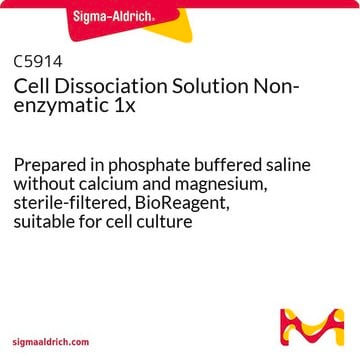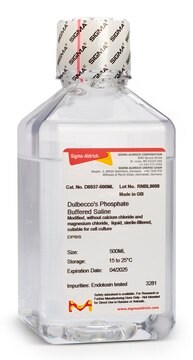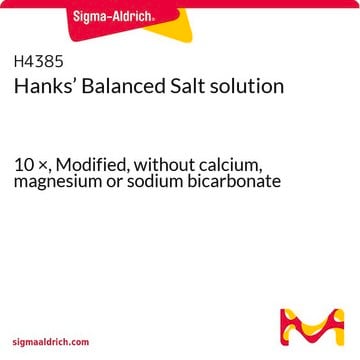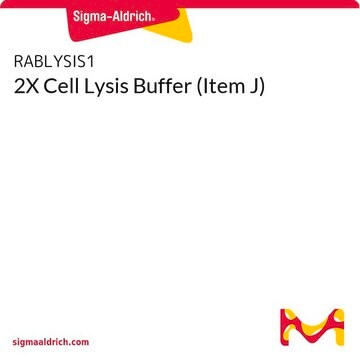This product contains EDTA as the major active component, which acts as a chelating agent for divalent cations to loosen cell–cell contacts but does not break down the extracellular matrix as trypsin does. Empirical testing is needed to determine if this approach is more effective. It is highly recommended to review the literature to determine if an EDTA-only dissociation method has been successfully used with the particular primary microglia preparation protocol.
C5789
Cell Dissociation Solution Non-enzymatic 1x
Prepared in Hanks′ Balanced Salt Solution without calcium and magnesium, sterile-filtered, BioReagent, suitable for cell culture
Sinónimos:
Cell Dissociation Reagent
Seleccione un Tamaño
Seleccione un Tamaño
About This Item
Productos recomendados
Nivel de calidad
esterilidad
sterile-filtered
Línea del producto
BioReagent
Formulario
solution
concentración
1 ×
técnicas
cell culture | mammalian: suitable
pH
6.5-7.5
Condiciones de envío
wet ice
temp. de almacenamiento
room temp
¿Está buscando productos similares? Visita Guía de comparación de productos
Descripción general
Aplicación
suplemento
Código de clase de almacenamiento
12 - Non Combustible Liquids
Clase de riesgo para el agua (WGK)
WGK 1
Elija entre una de las versiones más recientes:
¿Ya tiene este producto?
Encuentre la documentación para los productos que ha comprado recientemente en la Biblioteca de documentos.
Los clientes también vieron
-
Hi, I am working with primary microglia and it very tricky to dissociate. I usually dissociate them with 0.5% Trypsin for 7 min at 37˚C and still hard to collect them. May I know whether this reagent would be a better alternative? Thank you!
1 answer-
Helpful?
-
-
What is the concentration of EDTA in Cat#C5789? Thanks
1 answer-
The concentration of EDTA in this formulation is proprietary. Additional components include Sodium Citrate, Nitrilotriacetic Acid, and Glycerol in Hank's Balanced Salt solution. Should the concentration of EDTA be required, product E8008, EDTA 0.2% in DPBS, may be of interest. Both items are tested for cell dissociation. Please see the link below to review this product option:
https://www.sigmaaldrich.com/US/en/product/sigma/e8008Helpful?
-
Active Filters
Nuestro equipo de científicos tiene experiencia en todas las áreas de investigación: Ciencias de la vida, Ciencia de los materiales, Síntesis química, Cromatografía, Analítica y muchas otras.
Póngase en contacto con el Servicio técnico










